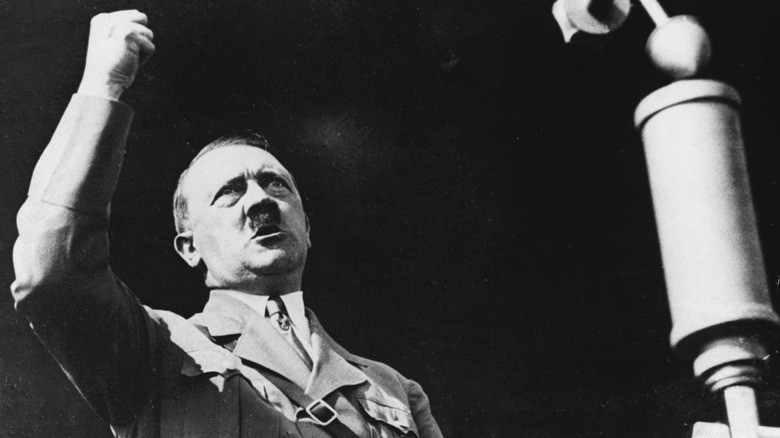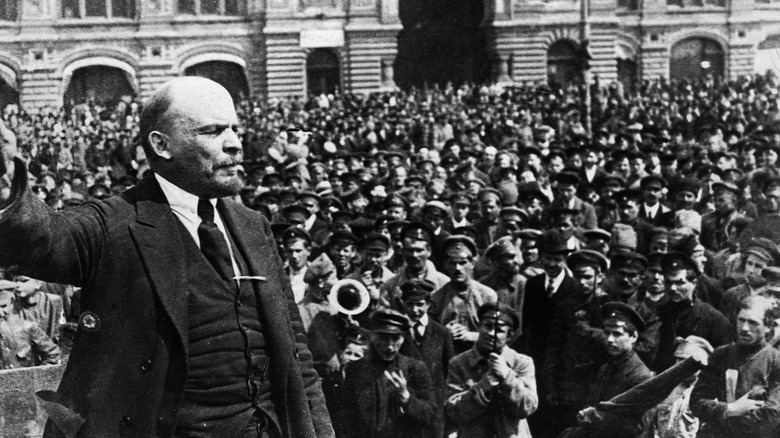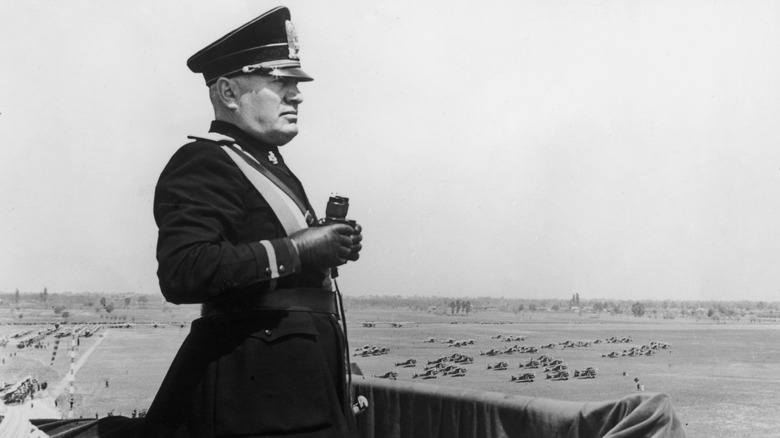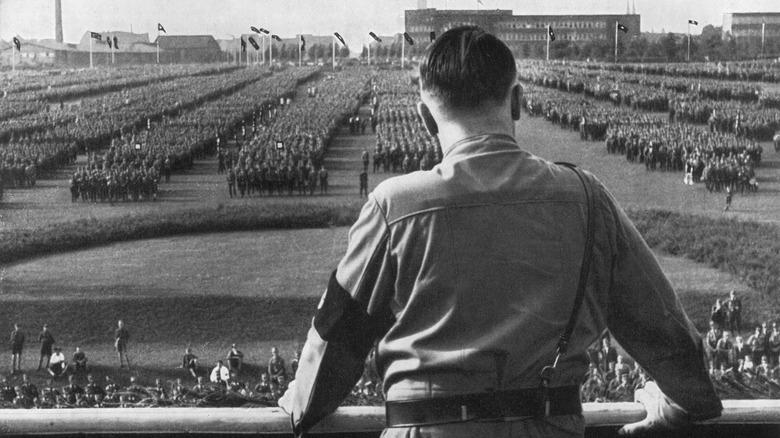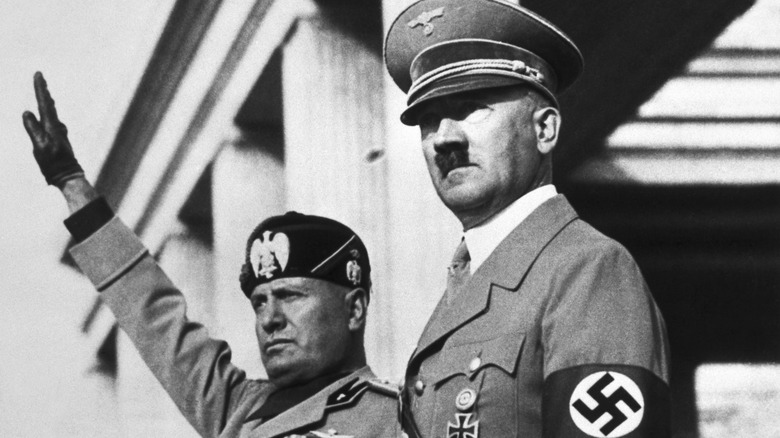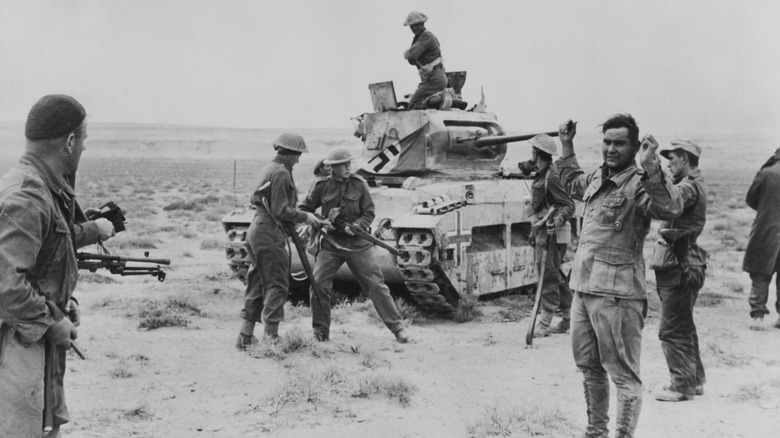Hitler's Chilling Connection To Mussolini Explained
It's neither new nor revolutionary to criticize democratic societies and governments. Building on hundreds of years of observation, the Greek philosopher Plato wrote precisely as much in 375 B.C.E. in one the most critical philosophical dialogues ever written, "The Republic." Speaking through his once-mentor and literary character Socrates, Plato concludes that "democracy" arises from disparity between the rich and poor, holds freedom and equality as its ideal, and therefore elevates the unworthy to positions of power, degrades into tyranny as the people's representative ultimately wields violence to remove perceived enemies of ideal societies, and democracy therefore becomes just another avenue for slavery, fear, and oppression.
Is it any wonder folks look to modern democratic societies and cry that the same could happen now? After all, Plato's ancient, eerily accurate conclusions already came true in the early-to-middle part of the 20th century during the heyday of civic republicanism. In 1922 Benito Mussolini became prime minister of Italy, albeit through a combination of legitimate legal measures and illegal strongman tactics, as History.com explains. Eleven years later in 1933, Adolf Hitler became chancellor of Germany through 100% legitimate, legally-prescribed means, as the National World War II Museum describes.
Both Mussolini and Hitler fit Plato's model of inherently corrupt, desire-driven leaders who transformed democratic governments into vehicles for domination. Both men also arose from the political left, not the right. They also took inspiration from a third tyrant, Vladimir Lenin, who while "exterminating the bourgeoisie as a class" during his 1917 Bolshevik Revolution executed up to 1.3 million people, per National Geographic.
The link to Lenin
Benito Mussolini and Adolf Hitler were fascists who adopted "state capitalism," whereby the state controls markets and owns the means of production. Vladimir Lenin, meanwhile, was a revolutionary Russian communist inspired by the political theories of Karl Marx. And while fascists and communists ought to despise each other — and often did so in public — they more often inspired each other. As the New York Times wrote, "No Lenin, no Hitler."
Case in point: Despite rejecting Marxism outright, Mussolini felt that "anything seemed possible" because of Lenin's Bolshevik Revolution, as Michael R. Ebner of Syracuse University says via History.com. Mussolini also adopted the same state capitalist model as Lenin, per the Library of Economics and Liberty; this was the "third way" that would bridge an oppressive past with an idealized future. And per Economic Affairs, Hitler wound up admiring this same non-free-market model.
Moreover, Lenin, Mussolini, and Hitler were bound by the same self-satisfying lust for power masked as an ideology of freedom – same as Plato described in "The Republic." Lenin didn't come to power through legitimate means like Mussolini and Hitler, but he presaged Mussolini and Hitler's reigns. Lenin presented himself as a mythical leader who brutalized a segment of his society in order to prop up his nation's "real" people, same as Mussolini and Hitler. To Lenin, those real people were the working class. To Mussolini and Hitler, they were the true, proud Italians and Germans who'd gotten the short end of the stick following World War I.
Mussolini was legally named prime minister
Much like other nations at the end of World War I, Italy faced extreme economic problems. As Britannica outlines, inflation ballooned, unemployment skyrocketed, people went on strike, public services like railroads ceased, and the Italian lira dropped to one-sixth of its original value from 1913 to 1920. Into this gap stepped Italy's Socialist Party, promising reforms and gaining support from the public, but in less than two years it splintered into the original party and the Italian Communist Party. This caused further sectarianism and fear amongst the public, and allowed Benito Mussolini to come to power through the support of Italy's National Fascist Party.
Ironically, Mussolini started out as a vocal member of Italy's Socialist Party, and editor of the socialist newspaper "Avanti!" ("Forward!"). The Spectator explains that after getting kicked out of the party in 1914 for advocating Italian neutrality in World War I, Mussolini turned radical. He fell in with Italian fascists who splintered from the political left and advocated for a strong national identity and state-controlled economy. They were anti-communist but admired the Lenin Bolshevik's revolutionary behavior.
Come 1921, as History.com explains, and Mussolini got elected to the Italian parliament's Chamber of Deputies. The next year, members of his own Fascist Party — dubbed "Blackshirts" — went around attacking and harassing Socialist Party members, union members, party member offices, etc. When Mussolini-supporting fascists marched on Rome, the Italian king Victor Emmanuel III dissolved the government and put Mussolini in charge of a brand new, Mussolini-formed government.
Hitler was legally named chancellor
Much like Italy, Germany was in a tight spot following World War I. As the National World War II Museum says, they'd been "humiliated" by 1919's Treaty of Versailles, which left Germany accepting responsibility for the entire war, paying back $33 billion in war reparations, and giving up colonies overseas. By the time the Great Depression flowed out from the United States in 1929, Germany was in shambles and folks needed a literal wheelbarrow of cash to buy a single loaf of bread. The country's economic problems were exacerbated by its Weimar Republic (1919 to 1933), a forced and unstable democratic republic that allowed Hitler to rise to power.
Hitler was a World War I veteran who'd joined the National Socialist German Worker's (Nazi) Party following the war's end. Much like Mussolini, Hitler rose through the ranks of his very fascist party via legitimate means, propelled by the power of rhetoric and the defamation of marginal groups like Jews. The Nazis also promised a restoration of German power, stabilization of the German economy, a restoration of German jobs, and so forth. By 1923, per the National World War II Museum, the Nazis also had their own private army of 15,000 troops, similar to Mussolini's Blackshirts.
The Nazis gained the majority in German parliament in 1932 and Hitler became chancellor in 1933. Just like in Italy, an emergency situation hit when a communist supporter started a fire in parliament's Reichstag building. The German president declared a state of emergency, civil liberties were suspended, and Hitler gained absolute power.
Hitler's and Mussolini's reluctant cooperation
Just because Benito Mussolini and Adolf Hitler rose to power through parallel, legal means, and shared a common ancestor in Vladimir Lenin — no matter how complex the connection — the two men didn't necessarily see eye-to-eye on everything. As Alpha History explains, their alliance in the Axis Powers during World War II was a "marriage of convenience and expedience" rather than anything else. And because Mussolini became prime minister 10 years before Hitler became chancellor, Hitler apparently admired Mussolini, one dictator to another. He especially admired the Fascist Party's march on Rome that gave Mussolini his power.
Mussolini didn't share Hitler's sentiments. He praised Hitler in public when Hitler became chancellor in 1933, but he considered himself the better of the two. Per Alpha History, he thought Hitler was "coarse" and "simplistic," and thought that the accomplishments of ancient Rome were superior to those of the Aryans described in Hitler's long-winded diatribes. By 1934, though, Hitler was by far the more politically powerful of the two, as Mussolini still needed to confer with King Victor Emmanuel III, per Yale University Press.
Bear in mind that all this happened before World War II broke out. Until then Mussolini and Hitler made agreements in secret, including to not engage in open war until 1943. Hitler violated this arrangement, however, when he invaded Poland in September 1939. Italy officially joined World War II on June 10 the next year, four days before the Germans reached Paris.
Twin falls from power, twin deaths
Benito Mussolini and Adolf Hitler shared far less time together as leaders during World War II than they did before the war. The two men rose to power through similar means and similarly fell. But, because Mussolini lacked Hitler's absolute governmental authority, he was vulnerable to legal recourse to remove him from power. And in 1943, a mere three years after Italy entered World War II and four years after Hitler started it, Mussolini and all his egotism and fascist ideals were simply voted out of office. Italians felt that they were on the losing side of the war, and Mussolini's Grand Council kicked him out. As History.com explains, it's likely that he was executed by firing squad on April 28, 1945. The next day his corpse was hung upside down in Milan for crowds to desecrate.
Folks familiar with this chapter in history might notice how shockingly close April 28 is to Hitler's own end. Tied together in origin, Mussolini and Hitler were tied together in death. The day after Mussolini died — and the day that he was hung upside down in Milan — Hitler married his mistress Eva Braun. The next day, on April 30, 1945, Hitler shot himself in the head. Germany had been on the losing side of the war and Hitler had fled to a bunker in January that year to live out his final days. Eight days later Germany surrendered.
